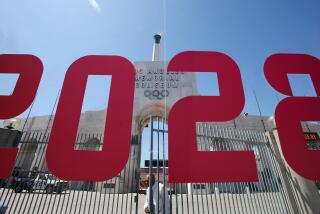Coliseum officials charged taxpayers thousands for fill-ups

As finance director for the Los Angeles Memorial Coliseum, Ronald Lederkramer didn’t need to do much driving to keep an eye on the stadium’s books.
But he has charged taxpayers about $7,600 for gasoline since 2008, even for fill-ups near Las Vegas and in Florida and New York. That was enough to drive about 12,000 miles annually in his Infiniti and his Jaguar, which he leased mostly at the public’s expense.
And on Lederkramer’s watch, four other stadium administrators racked up similar bills on the Coliseum’s Exxon Mobil account, according to receipts obtained through the California Public Records Act. The managers’ jobs required only occasional car trips, typically to nearby destinations such as Staples Center or City Hall, Coliseum officials have said.
In addition to the gas charges, the Coliseum’s top employees spent thousands of dollars on Riviera Country Club golf tournaments, hotels, steakhouse lunches and Bel-Air Country Club breakfasts. Lederkramer, whose compensation last year was $195,000, and one other manager were also reimbursed for personal medical costs, the receipts and other expense records show. Some of the medical expenses were for massages and a snoring treatment.
The newly disclosed expenditures were among hundreds of invoices, expense reports and individual transactions reviewed by The Times. They show that few cost controls were imposed by the Coliseum’s governing commission, a money-losing operation mired since February in a financial scandal. The nine commissioners are appointees of the state, the city of Los Angeles and the county Board of Supervisors.
Much of the spending, which occurred as Coliseum employees were taking furlough days to save money, continued under interim General Manager John Sandbrook. He took the helm of the Coliseum six months ago after its longtime chief, Patrick Lynch, resigned under a cloud. Lynch had allowed the stadium’s events manager to conduct official business with a rave concert company that was paying the manager’s private firms for related work at the Coliseum.
Sandbrook stopped Lederkramer’s gas purchases only last month, several weeks after The Times inquired about them, according to the county counsel’s office, which represents the commission.
Los Angeles City Controller Wendy Greuel, who is preparing to audit the commission, said the gas expenses and many others would not be allowed under the city’s rules. Any driving costs billed to the city, she said, “must be for a public benefit, not a private benefit.”
“Who’s managing the store?” Greuel said. “It looks like there were no controls, no one in charge.”
Steve Ellis, vice president of the watchdog group Taxpayers for Common Sense, said Lederkramer, as chief finance officer, had a particular duty to ensure that the gas and other expenses he approved were for government purposes.
“Taxpayers have every right to be outraged,” he said.
Lederkramer, who is on medical leave, and Sandbrook did not respond to interview requests.
County Supervisor Mark Ridley-Thomas, a commissioner, acknowledged that oversight by the Coliseum panel “left a lot to be desired.” He said the commission would hire its own auditor.
“We have to go deep to straighten all this out,” Ridley-Thomas said.
Even as the Coliseum and companion Sports Arena slipped further into the red, the dollars flowed.
From 2009 until June of this year, the commission reimbursed Lederkramer $16,546 for travel, meal and convention expenses, according to the documents. Last February, he billed the commission $1,267 to stay at the Hyatt Regency Huntington Beach Resort and Spa -- 37 miles from the Coliseum -- for a Stadium Managers Assn. conference.
Lederkramer also has charged the commission for numerous meals at Morton’s steakhouse. He had Sunday breakfasts with Sandbrook at the Bel-Air Country Club, also at the agency’s expense.
Since 2007, the Coliseum has spent $34,600 to enter Lederkramer and others in golf tournaments sponsored by the Los Angeles Sports and Entertainment Commission, a privately funded nonprofit that raises money to promote events here. The Coliseum panel did not respond to questions on how the public benefited from Lederkramer’s participation in any of the tournaments.
The Coliseum also spent thousands on Lederkramer’s personal medical costs. During one 13-month period, he received commission checks totaling $2,139 for chiropractor visits, $910 for drugs and $500 for a procedure to treat snoring. He charged the commission $1,000 for a single visit to a New York physician known for using psychological methods to treat lower back pain, the records show.
Lynch approved the reimbursement arrangement in 2001, with a $6,000 annual ceiling, according to a copy of an agreement between the two administrators. Lederkramer requested it on grounds that he was saving the commission money by choosing to be insured by his wife, a UCLA employee. Sandbrook has kept the arrangement in place, saying in an email to the commissioners that it would be reviewed by an outside consultant. The Times has copies of the agreement and email.
The county counsel has not responded to a Times request for proof that Lederkramer’s medical costs were not paid by his wife’s insurance or that they were otherwise appropriate for reimbursement.
The stadium’s former events manager, Todd DeStefano, also benefited from an agreement with Lynch to charge the commission for some medical expenses. Although DeStefano was enrolled in the commission’s health plan, he was reimbursed $400 to see a physician and $2,196 for massages, the records show. DeStefano quit in January.
The gas receipts show that like Lederkramer, Lynch and DeStefano filled their tanks on a regular basis near their residences. From 2008 until they left the commission, Lynch bought about $8,100 worth of gas and DeStefano $7,500, enough to drive about 15,000 miles a year each based on miles-per-gallon ratings for their cars -- a Cadillac and a BMW.
Like Lederkramer, Lynch and DeStefano made purchases at various times at an Exxon Mobil station in Jean, Nev., a roadside town about 30 miles outside Las Vegas.
The Coliseum’s technology manager, Leopold Caudillo Jr., charged the commission for about $5,215 in gas from May 2009 through last June. One of his fill-ups was in Pennsylvania. Caudillo was placed on administrative leave after The Times reported earlier this month that he directed Coliseum business to a firm he founded with a stadium co-worker.
The venue’s former chief administrative officer, Margaret Farnum, kept her gas card after she retired in 2008 and was rehired by the Coliseum to create a sports museum, a project that never happened. She spent about $4,000 on gas in the 3 1/2 year period covered by the receipts.
The gas cards complemented other car perks. Lynch drove a Cadillac the commission provided to him. Lederkramer and DeStefano received $600 monthly car allowances. In the 2 1/2 years ending in June, the commission reimbursed Lederkramer $7,463 for leasing costs, DMV renewal fees, insurance and maintenance for his cars.
Sandbrook has said he would wait for a report by an outside compensation consultant before deciding whether to end the car allowances. The retired UCLA administrator was recruited for the Coliseum job by County Supervisor Zev Yaroslavsky, a Coliseum commissioner who has been Sandbrook’s friend since they attended UCLA together.
Yaroslavsky said Sandbrook inherited a “cesspool” and “has done as good a job as he possibly could under the circumstances,” including in preparing the stadium for the USC football season. “He couldn’t fire everybody.”
Another commissioner, City Councilman Bernard C. Parks, has said Sandbrook and Lederkramer should be fired.
In 2010, Lynch, whose $291,000 compensation included a $125,000 bonus, sent employees a memo ordering them to take six unpaid furlough days because the Coliseum and Sports Arena “have lost a significant amount of money due to the lack of events.”
“We must now make some sacrifices,” Lynch wrote to the staff members, some paid as little as $26,000 a year.
He added that employees with questions should address them to Lederkramer, who received bonuses last year totaling $34,500.
paul.pringle@latimes.com
ron.lin@latimes.com
More to Read
Start your day right
Sign up for Essential California for news, features and recommendations from the L.A. Times and beyond in your inbox six days a week.
You may occasionally receive promotional content from the Los Angeles Times.







